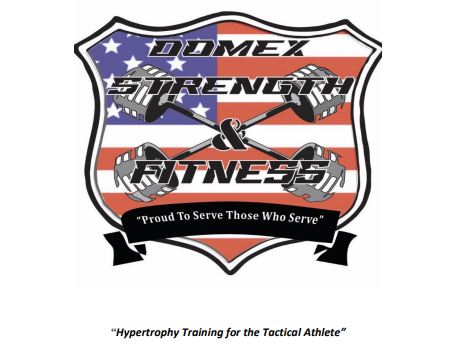Hypertrophy
(aka-Muscle Building)Training
for the Tactical Athlete
With the DOMEX Strength & Fitness PROGRAM DESIGN

Save Time
This course provides step-by-step guidance through each DEA (PTA) chapter, ensuring you stay on the right path to pass the exam.

Save Money
Achieve cost savings by successfully passing the exam on your initial attempt.
Course Curriculum:
Course Overview:
In order for the men and women that are serving in today’s law enforcement profession to perform optimally in their assigned duties, they have to prepare themselves as “Tactical Athletes,” and a sound program design based upon hypertrophy or muscle building is paramount. A tactical athlete is an individual that is in the law enforcement, firefighter, military or 1st responder profession that needs to possess the athletic prowess to perform optimally day in and day out within their job description. These individual’s professions are without a doubt, extremely challenging and rewarding but are encountered with a myriad of variables. No matter what the 1st Responder’s current assignment is, training as a tactical athlete will contribute to optimal performance and career longevity. Strength and conditioning is paramount in order to elicit premium physiological adaptations that will result in becoming a better public servant, for themselves, their co-workers and the community they serve. They need to exhibit feats of: strength, power, muscular endurance, aerobic capacity, anaerobic capacity, flexibility, stability and mobility through everyday functional movements to aid in better human performance. Whether you are a tactical athlete, planning to become one or want to train like one then we have the right programs for you. The tactical athlete lastly, and equally important needs to move their body in all three anatomical planes of motion confidently and precisely for better performance and to avoid the onset of musculoskeletal injury (MSK).
Course Description:
The program design included here is for the individual to work on their adaptations of Hypertrophy – AKA – Muscle Building. Without a doubt, having a desirable amount of lean body mass and well-developed muscle will assist in your daily duties but will additionally give you the added confidence and improve your command presence during performance of your daily duties. This in turn will also contribute to optimal performance and career longevity. Additionally, hypertrophy is crucial for the tactical athlete who finds themselves lifting and moving external loads or resistive forces repeated times throughout their daily jobs. Developing sufficient muscle through a hypertrophy routine would be accomplished through performing submaximal contractions and repetitions with a certain force or object. An example would be to conduct a bench press, squat or bicep curl for generally 8-12 repetitions. This repetition count correlates to an intensity of approximately 67-80 % of your One Repetition Maximum (1RM). Furthermore, the exact rest periods are programmed into this four-week program which will keep you focused on building the physiological adaptations of hypertrophy or building good quality muscle. By building hypertrophy or adding new muscle growth, you will make the physiological adaptations that will improve your anaerobic metabolism. In a hypertrophy routine, the volume is high and the intensity is low to moderate, whereas in a strength and power routine, the volume is low to moderate but the intensity is high. Training for hypertrophy will mitigate an individual’s risk for musculoskeletal injury or MSK. When beginning this program and progressing through same, your strength will improve and the eventual addition of weight added to your routine will increase. Keep in mind to generally not make more than a 10% weekly linear progression of weight added from week to week for best safety practices.
How a tactical athlete training program prepares for functional fitness
Now that the job description and role of a ‘tactical athlete” is clearly defined, and why hypertrophy gains or building muscle is needed for the tactical athlete, then how does an individual train like a “tactical athlete?” Some of the variables that need to adhered to when implementing a sound program design for a “tactical athlete” should be centered upon the following:
- Conducting training based upon a tactical athlete’s job description entails devising a program design for what they do through utilizing the three anatomical planes of human movement. Training this way makes the tactical operator better equipped to successfully conquer any physically demanding task they encounter. Not only does this accomplish these objectives but equally important, assists the operator in aiding them in preventing Musculoskeletal (MSK) injuries. The three anatomical planes of human movement are the following:
- (A) Saggittal plane which separates the left and right sides of the body.
- (B) Frontal plane which separates the anterior and posterior of the body.
- (C) Transverse plane which separates the upper (superior) and lower (inferior) halves of the body

“Tactical athlete” training through all 3 anatomical planes of human movement.
The following is a brief list of how a “tactical athlete” should center their training upon which takes into account of all three anatomical planes of movement. This is not an all-inclusive list but rather a representative sample of the desired movement patterns in order to elicit optimal physical performance.
- Resistance Training Exercise Techniques – Bench press, deadlift, squat, Romanian Deadlift and several more with the purchase of the program.
- Bodyweight Exercises: Pull/Chin-ups, push-ups, planks and several more with the purchase of this program.
- Flexibility and Mobility Exercise Techniques and Programming – Mobility is affected by one’s ability to move freely through coordination and without restriction. Flexibility does not indicate the ability of movement but rather the ability for one to develop a range of motion for ones muscles, ligaments and tendons. Stability is ability to maintain control of joint movement around its axis. Types of stretching – Static, ballistic and dynamic. It should be noted that “dynamic stretching” is considered one of the premium forms of stretching to be effected before conducting an exercise session as it raises the core temperature of the body in preparation for exercise. (Further explanations of dynamic stretching with examples can be found at our IG page of @Domexstrengthandfitness and linked articles on this website.)
Aerobic Endurance Exercise Techniques and Programming
The following is a program design of a sample basic weekly workout with the goal of aerobic conditioning and addresses the recommended frequencies or volume and how many days/times each modality is programmed. The methods used will be either running, rucking or swimming. The aerobic portion can be divided into the following segments which include: Long Slow Distance (LSD), pace/tempo and interval running. ***This is a bonus feature added onto this Hypertrophy program.***

